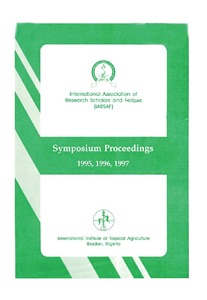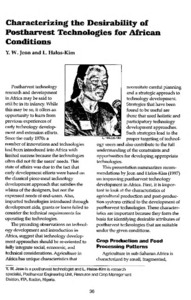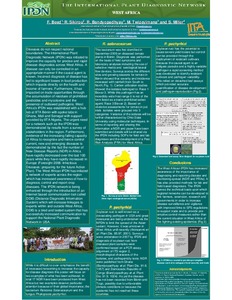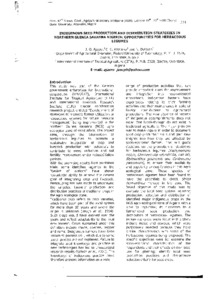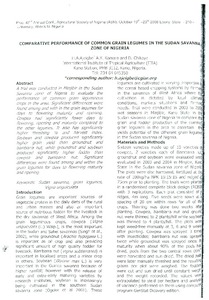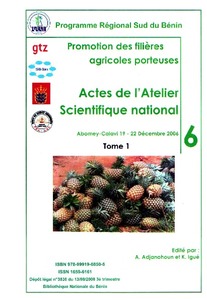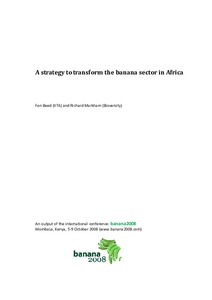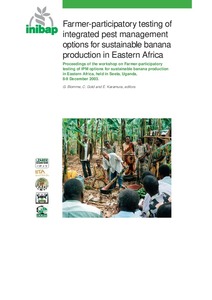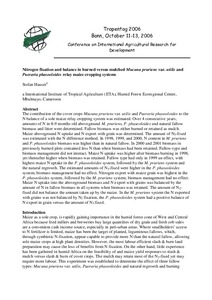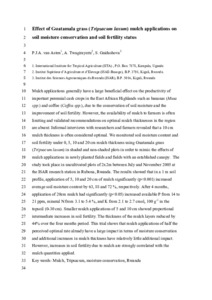Welcome to the International Institute of Tropical Agriculture Research Repository
Conference Documents: Recent submissions
Now showing items 581-600 of 726
-
Mapping and monitoring agricultural land use in West Africa
(2008)West Africa has experienced increases in cultivated lands over the last 50 years in order to meet increasing demand from rapidly growing populations. Most countries in the region still depend on agriculture as an important part of the economy. In most countries however agricultural productivity is low leading to food insecurity and poor performance of the whole sector. In the Maputo declaration of 2004 the African governments committed to spending at least 10% of the national budget resources on ... -
Cassava improvement in sub-Saharan Africa: contributions of IITA and its partners
(2008)Cassava is well recognized for its capacity to address food needs of vulnerable communities in unstable environments in SSA. IITA and colleagues in African NARS, in collaboration with CIAT and ARIs have played leading roles in the development of improved cassava varieties which are disease and pest resistant, early maturing, and high yielding. Through a combination of conventional and new approaches, over 400 cassava genotypes have been developed. The characteristics of the new generation of cassava ... -
The International Plant Diagnostic Network West Africa
(2008)Diseases do not respect national boundaries. The International Plant Diagnostic Network (IPDN) was initiated to improve the capacity for precise and rapid disease diagnostics across West Africa. A disease can only be controlled in an appropriate manner if the causal agent is known. Incorrect diagnosis of disease has led to significant losses in food production which impacts directly on the health and income of farmers. Furthermore, it has impacted on trade opportunities through the accumulation ... -
Ploidy versus gender effects on inheritance of quantitative traits in Musa species
(2008)Several factors including ploidy and genome composition influence the inheritance of agronomic traits in Musa populations. Research results have indicated that gender determines the inheritance of quantitative traits in this species, but whether inheritance patterns are ploidy-dependent or gender-dependent is not known. The present research is therefore aimed at evaluating the agronomic performance of progenies of 4x - 2x versus 2x - 4x crosses in Musa, in other to understand how gender or ploidy ... -
Comparative performance of common grain legumes in the Sudan savanna zone of Nigeria
(2008)A trial was conducted in minjibir in the sudan savanna zone of Nigeria to evaluate the performance of common grain leguminous crops in the area. Significant differences are found among and within the grain legumes for days to flowering, maturity and ripening. Cowpea had significantly fewer days to flowering, ripening and maturity compared to other legumes. It also has significantly higher threshing % and harvest index. Soybean and cowpea produced significantly higher grain yield than groundnut and ... -
Inventaire et importance des degats des mouche des fruits sur quelques especes de cucurbitacees au Benin
(2008)Le complexe de mouches des fruits ainsi que les taux d'infestation des agrumes avaient été évalués suite à des prospections effectuées dans presque toutes les zones agrùécologiques du Bénin at complétées par des études faites au niveau de trois vergers agrumicoles au Sud du Bénin. Des échantillons de fruits des plantes hôtes potentielles, locaUsées autour de chacun des trois vergers, avaient été aussi prétevés. Bactrocera invadens une aspèce très récemment introduite en Afriqt.ie, était de loin ... -
Contribution of soil quality to banana yield problems and its relation with other banana yield loss factors
(2005)In Uganda, highland banana yields (5-30 t ha-1yr-1) are low in comparison to potential yields (70 t ha-1yr-1) due to high pest and disease pressure, soil fertility decline, and poor management. Although it is generally accepted that soil exhaustion is a major cause of low and declining yields, there are almost no data to demonstrate this relationship. Most studies show that banana soils are relatively fertile and often contain sufficient nutrients for optimum growth. Nonetheless, K, N and Mg ... -
Environmental influences on shoot and root growth in banana and plantain
(2005)Studies on the influence of environmental conditions on Musa plant growth have predominantly focused on dessert bananas (Musa AAA group). The effect of location, field within location and planting date on shoot and root traits of field-grown flowering plants of 6 Musa spp. genotypes belonging to 4 Musa groups was determined in this study. Results show that Musa spp. are highly sensitive to environmental changes and that soil structure, soil fertility and water regime can have significant effects ... -
Banana and plantain (Musa spp.) growth depends on size and physiological stage of planting material
(2005)The influence of the size and physiological stage of the sucker-derived planting material on subsequent root and shoot growth of banana and plantain has not been studied in detail. The objective of this study was to evaluate associations between traits of the sucker planting material and root and shoot traits of the sucker-derived plants for different Musa spp. genotypes. Sucker-derived plants of 2 plantain landraces: 'Bobby Tannap' and 'Obino l'Ewai' and 6 plantain-derived hybrids were assessed. ... -
Nitrogen fixation and balance in burned versus mulched Mucuna pruriens var. utilis and Pueraria phaseoloides relay maize cropping systems
(2006)The contribution of the cover crops Mucuna pruriens var. utilis and Pueraria phaseoloides to the N balance of a sole maize relay cropping system was estimated. Over 4 consecutive years, amounts of N in 8-9 months old aboveground M. pruriens, P. phaseoloides and natural fallow biomass and litter were determined. Fallow biomass was either burned or retained as mulch. Maize aboveground N uptake and N export with grain was determined. The amount of N2-fixed was estimated with the N difference method. ... -
Trends in farm labour productivity and implications for cassava industrialisation in Nigeria
(2006)Nigeria is presently the largest cassava producing country in the world. Cassava production is primarily at the smallholder level relying heavily on the hoe and cutlass and driven by human physical effort. Agricultural farm labour is a critical factor as Nigeria strives to utilise cassava as an industrial crop. With increase in rural urban migration, the aging of the rural population, and the feminisation of agriculture, rural farm labour is likely to remain inelastic and expensive for agro ... -
Effect of Guatamala grass (Tripsacum laxum) mulch applications on soil moisture conservation and soil fertility status
(2007)Mulch applications generally have a large beneficial effect on the productivity of important perennial cash crops in the East African Highlands such as bananas (Musa spp.) and coffee (Coffea spp.), due to the conservation of soil moisture and the improvement of soil fertility. However, the availability of mulch to farmers is often limiting and validated recommendations on optimal mulch thicknesses in the region are absent. Informal interviews with researchers and farmers revealed that a 10 cm mulch ...


